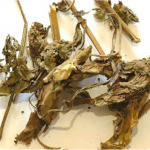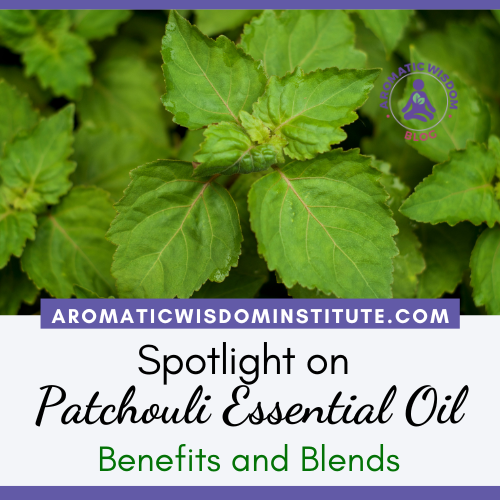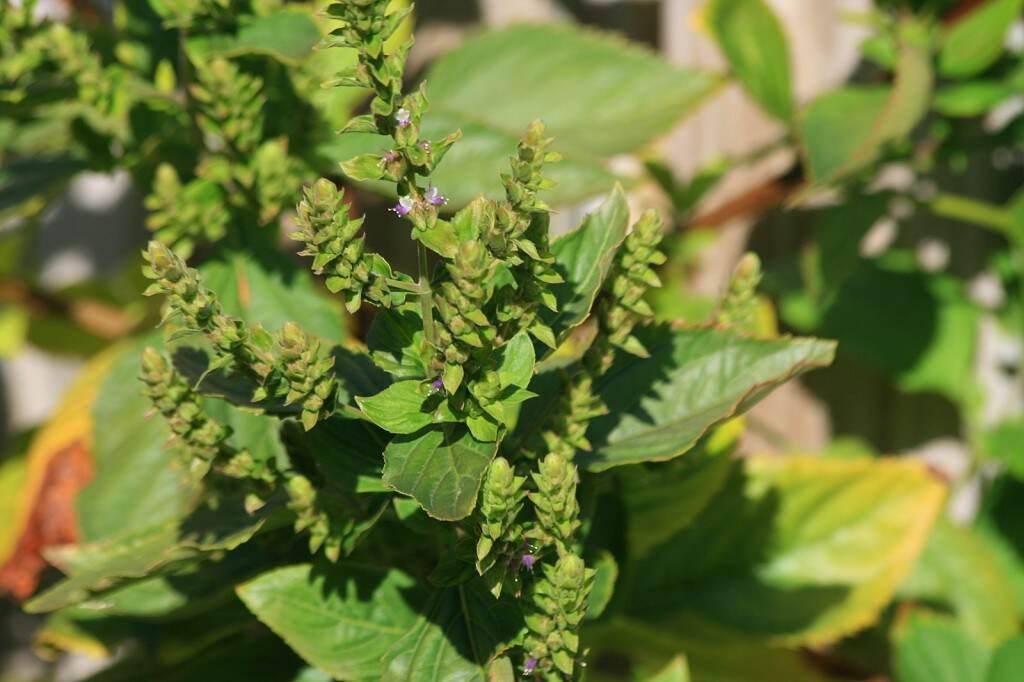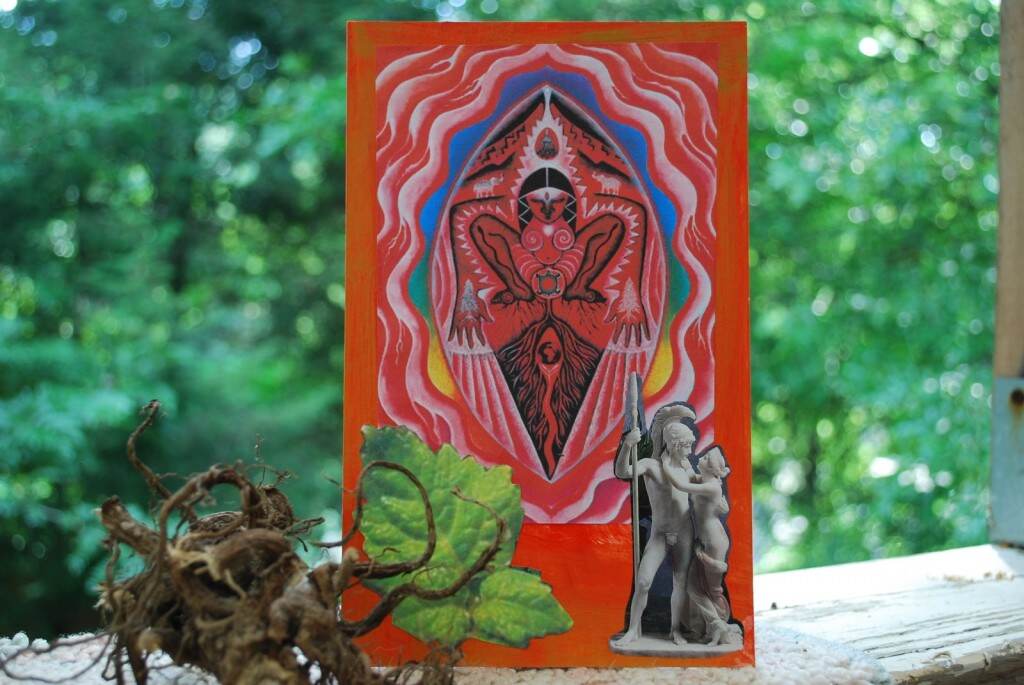Today’s featured essential oil has become a favorite of mine over the years.
It has grounding qualities that can help stabilize and assuage an overactive mind,
thus helping prevent mental burnout.
Essential Oil of Patchouli
Pogostemon cablin
I found this great photograph of a patchouli plant on
Danielle’s Garden Blog.
(Here’s a fun post she wrote called How to Grow Patchouli)
My Personal Relationship with Patchouli Essential Oil
Patchouli has a very distinctive aroma that people either love or hate. For years I was in the latter category. I couldn’t stand the aroma. Then the circumstances of my life changed. One day I discovered that not only could I tolerate the aroma of patchouli, but I enjoyed it!
Why did I rebuke the oil in one life and embrace it in another? I have no idea. However, I do believe that we, as intuitive beings, are drawn to the oils that offer what we need at certain times in our life.
The Foundations
Geographical Sources: Patchouli is native to tropical Asia, especially Indonesia and the Philippines.
Extraction: Steam distillation of the dried leaves.

Characteristics: Patchouli is a heavy, rich essential oil with a dark amber color. The aroma is sweet and earthy with a real staying power, so a little goes a long way! The fragrance is one of those rare aromatics that will improve with age. A young Patchouli, freshly distilled, smells more green and sour than when a few years in the bottle. I have several bottles of vintage Patchouli more than 20 years old and each are incredibly rich and mellow. Before using this essential oil on a client or in a blend for others, keep in mind that many people do not like the aroma of this oil, so ask before adding it to their blend or gifting it.
Chemical Families: Sesquiterpenes and Sesquiterpenols
Safety: Nontoxic, non-irritant, non-sensitizing.
Therapeutic Properties:
- Alleviates inflammation
- Kills bacteria
- Reduces stress, depression, and anxiety.
- Used in blends for skin conditions such as dryness, inflammation, scars, and sores.
- Energetically balancing for an overactive mind and for nervous strain.
Some Suggested Applications:
- Add to any blend for an antidepressant effect.
- Use in a blend of Aloe vera gel for weepy eczema or in cream as a skin moisturizer.
- Add to any massage carrier oil for soothing an overactive mind and to encourage sleep.
- Put about 5 drops on your natural incense to repel insects
Blends well with these essential oils: Cistus, Vetiver, Sandalwood, Geranium, Lavender, Rose, Bergamot, Myrrh
A Recipe Using Patchouli Essential Oil:
Insect Repellent
4 drops Patchouli Essential Oil (Pogostemon cablin)
5 drops Cedarwood, Virginia Essential Oil (Juniperus virginiana)
3 drops Eucalyptus Essential Oil (Eucalyptus globulus)
4 drops Geranium Essential Oil (Pelargonium graveolens)
2 drops Vetiver Essential Oil (Vetiveria zizanoides)
2 oz Organic Aloe vera gel
2 oz spray bottle
Directions: Add the essential oils to the 2 fl oz spray bottle then fill up with the Aloe vera gel. This recipe is safe to spray on your skin.
Subtle Properties (vibrational and energetic)
 Patchouli is an important oil in the energetic realm because it strongly resonates with our base chakra which grounds and strengthens the will to live. This oil opens the chakras in the feet and draws energy from Mother Earth.
Patchouli is an important oil in the energetic realm because it strongly resonates with our base chakra which grounds and strengthens the will to live. This oil opens the chakras in the feet and draws energy from Mother Earth.
According to Joni Keim, Patchouli resonates with the following chakras:
- Base (1st): Strengthens and ground this energy center, relieving deficiencies in the base energy center. Reattaches the physical body with subtle bodies.
- Sacral (2nd): Spiritualizes sexuality. Facilitates enjoyment of the senses and awakening of creativity.
- Third Eye (6th): Relaxes a tense, over-active intellect.
- Feet Centers: Opens feet centers to connect with a draw earth energy.
Two Personal Patchouli Stories:
1. I once used Patchouli on the arm of a massage client who has twice-weekly dialysis and her arm is thick with scar tissue. I used a 1% blend on her arms and used gentle circular friction on her keloids to help break them down.
2. My husband and I both like the aroma of Patchouli and find it relaxing, so I will often add a capful of Patchouli essential oil to the rinse cycle when washing our bedsheets. Even after the sheets have been in the dryer, the linens contain a gentle version of the fragrance. If I forget to add it to the rinse cycle, I’ll sometimes dab it on an old dryer sheet and toss it in during the cooling cycle of the dryer.
The Hippie Connection: Patchouli was the scent of the psychedelic 1960s and early 1970s. It was used to help cover the tarry scent of marijuana. It has a strong memory association for me with the “head shops” of that time period. A few years ago I was asked to give a talk on aromatherapy to the employees of Allenwood Federal Prison. There were several speakers that day and the audience consisted of office staff, guards, and the Warden. I received the usual questions about essential oils, but when I got to Patchouli and mentioned this bit of trivia about it masking the aroma of marijuana, the guards became very attentive and full of questions. Apparently many of the inmates like Patchouli oil!
Patchouli was the scent of the psychedelic 1960s and early 1970s. It was used to help cover the tarry scent of marijuana. It has a strong memory association for me with the “head shops” of that time period. A few years ago I was asked to give a talk on aromatherapy to the employees of Allenwood Federal Prison. There were several speakers that day and the audience consisted of office staff, guards, and the Warden. I received the usual questions about essential oils, but when I got to Patchouli and mentioned this bit of trivia about it masking the aroma of marijuana, the guards became very attentive and full of questions. Apparently many of the inmates like Patchouli oil!
My Patchouli Aromatic Wisdom Insight Card™:
- I am one who harmonizes the earth element with your mind, mentally grounding you and bringing you back to your feet.
- I am one who invites sensual pleasure.
- I am one who is steeped in ancient cultures of the East.
- I am one whose rescues you from the nervous strain and mental overload of your own overactive mind.
References:
1. Battaglia S. The Complete Guide to Aromatherapy. 2nd edition, The International Centre of Holistic Aromatherapy, Australia, 2003
2. Davis P. Aromatherapy an A-Z. New revised edition C.W. Daniel Company Limited, England, 1999
3. Keim, J. Daily Aromatherapy, North Atlantic Books, USA 2008
4. Keville, K. Aromatherapy, A Complete Guide to the Healing Art, The Crossing press, USA, 1995
5. Mojay G. Aromatherapy for Healing the Spirit, Henry Holt and Company Inc., England, 1996
6. Price S. Aromatherapy for Health Professionals, 2nd edition, Churchill Livingstone, 1999
7. Schnaubelt K. Advanced Aromatherapy, The Science of Essential Oil Therapy, Healing Arts Press, USA, 1998
8. Tisserand R. The Art of Aromatherapy, Healing Arts Press, USA, 1977
This blog post was updated for accuracy and relevance on June 6, 2023
This blog post may contain affiliate links which means I may receive a small commission if you make a purchase using them.
The commission is paid by the retailer at no extra cost to you.







I love this post Liz! The soul collage is beautiful and the Insect Repellent recipe is so great-I can tell it will smell much better than most Insect Repellents!! Thanks for your incredible blog, I enjoy all your posts!
Andrea
Aromahead.com
Thanks so much Andrea! I must admit, this is my favorite Soul Collage card too 🙂
Liz, thanks for all of the great info about patchouli! I am not familiar with it but would like to give this a whirl!
Sherie, I would definitely suggest smelling a sample before purchasing since it has an aroma that not everyone loves. But then, there are those that are GAGA for it!
Love essential oils and I always learn about one that I have never heard of from you ;-). Thanks for sharing, Liz!
Kim, I love that you are learning about new essential oils here. And I haven’t even gotten into some of the more exotic ones yet! Stay tuned!
The power and effectiveness of essential oils is incredible! Thanks for sharing this information…it is one that I haven’t tried yet!
Denny, isn’t that the truth! Let me know what you think of Patchouli when you try it.
I’m new to learning about the essentials oils – great info here on Patchouli. Really enjoyed it!
I’m new to learning about the essentials oils – great info here on Patchouli – makes me want try it.
Very new to essential oils.I know what I like in aromas though. I like Lilac so anything I can find that smells like this I like. very interesting article.I will stay tuned to your next blog posts.
You might like to start with a simple bottle of Lavender essential oil. Thanks for stopping by!
Thank you for sharing your knowledge with us! I enjoy learning more about oils and other forms of natural life enhancement!
Stacy, you’re so welcome!
Hi Liz ~ Thanks for the information on essential oils. I found it interesting and look forward to learning more. ~ Rebecca
Thanks Liz, this is great information especially personal story #2. I used to really be into essential oils and I did notice a difference in mood. I need to get back! 🙂
I’ve never heard of Patchouli but sounds like I should check it out…like it’s benefits.
Patchouli Essential Oils has SO many therapeutic benefits Pamela! Thanks for visting!
Liz
Liz, you are such a teacher; just awesome! There is so much to learn about the essential oils, they are such a great resource! I will stay tuned!
Great information about essential oils. Thanks for sharing.
Hi Vicky ~ Thanks very much!
I had no idea you could use patchouli to quiet your mind. I’ve not had any of it around here in years, so maybe it’s time to test it out again. Thanks Liz!
And the great thing is, Helena, that it is probably still good because it has a long long shelf life!
I am defiitely not a fan of the frangrance but am a Big fan of the beefits! Great article, Liz!
Ha! That’s very honest Carl! Lucky for you, there are other oils with many of the same benefits.
I find this very interesting when you said ‘I do believe that we, as intuitive beings, are drawn to the oils that offer what we need at certain times in our life.’
I can’t explain the curiosity I have with that…like so many other things we intuitively gear toward, this being one of them is really interesting 🙂
Interesting Liz! Thank you for sharing your knowledge about essential oils! I can imagine the smell being a lot better compared to chemicals we currently use at home. Great recipe!